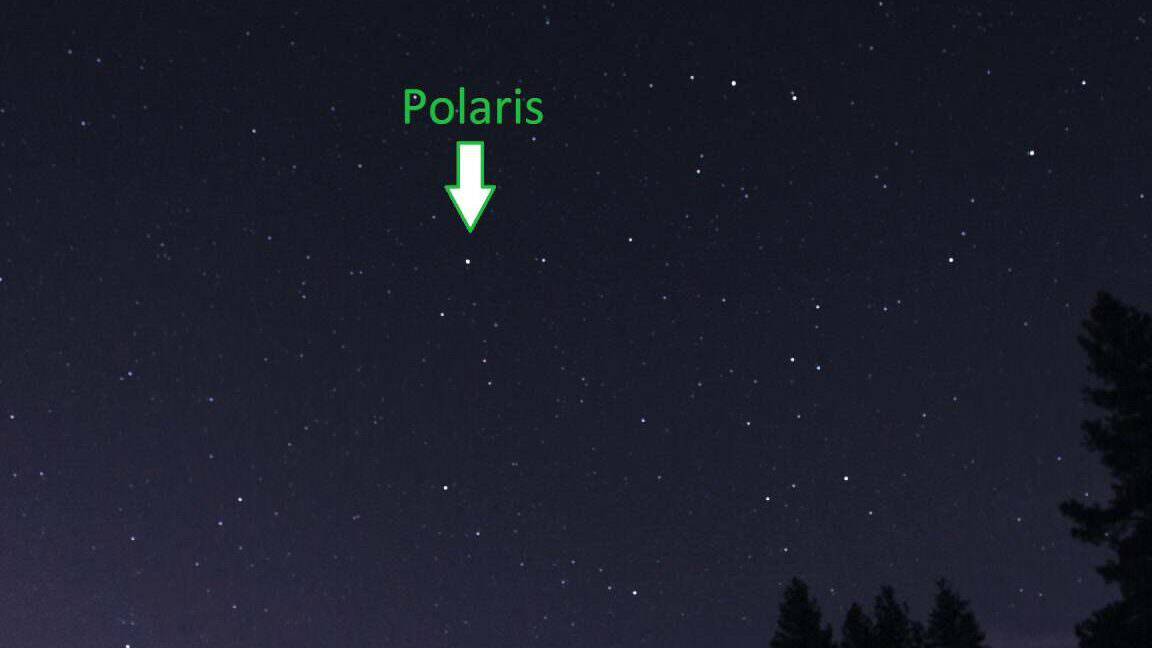The planet Polaris falls into the category of a unique celestial body. Its position in the sky is such that the north pole of our planet is almost aligned with it. As a result, as the Earth rotates, Polaris appears to be stationary while all the other stars revolve around it. This phenomenon makes Polaris a fascinating and distinctive planet in our galaxy.


The camera used for this photo is the Sony ILCE-7C, paired with the Tamron 11-20mm f/2.8 Di III-A RXD lens.
ISO – 640; aperture F/2.8; shutter speed 273s.

Reply to the post “The Sun is the largest star!”
I have my own issue with Polaris. It’s interesting that 9 out of 10 individuals I know, when asked which star is the most brilliant, confidently answer: “Polaris.” It takes a significant amount of time to explain that it doesn’t even rank among the top 20 brightest stars in the Earth’s sky. You have to overcome their skepticism, assert your authority, show them Polaris and Arcturus in the sky, and finally convince them. A year goes by, and people go back to believing their misconception.
The other side of the coin is that for people, Polaris is the brightest one in the sky at that moment. Rukalitsu.jpg.

What is the significance of Polaris?
Polaris, also known as the North Star, holds a special position in the sky. It is located directly above the Earth’s axis of rotation on the northern side. As a result, Polaris remains almost stationary in the night sky while other stars revolve around it in circular patterns.
In the northern hemisphere, Polaris serves as a reliable guide for navigation. By locating Polaris, one can easily determine the direction of north when observing the night sky.




Did you swim, devour watermelon, or gather around a campfire? How did you spend your summer?
Even if your summer was filled with work, don’t lose hope. We have a fun activity to help you make the most of the summer! Create a compilation of summer mementos and earn a special feature on Peekaboo. Plus, you’ll discover how to bring the essence of summer to any season.


Stellar Orbit. Captured with a Sony a6300. Samyang 12mm F/2.0 NCS CS. ISO 2000. 32.5 minutes of shutter speed. Chuvash Republic

The North Star

Polaris: The Brilliant Star in the Orion Constellation
When gazing up at the dark expanse of the night sky, we are greeted with a magnificent display of countless celestial bodies. Among them, numerous stars have been extensively studied and documented.
Nevertheless, even the most well-known stars still possess a myriad of enigmatic qualities.
One such enigma is none other than Polaris, the alpha star of the Ursa Minor constellation.

Polaris
It indicates the direction. However, its guidance is only temporary.
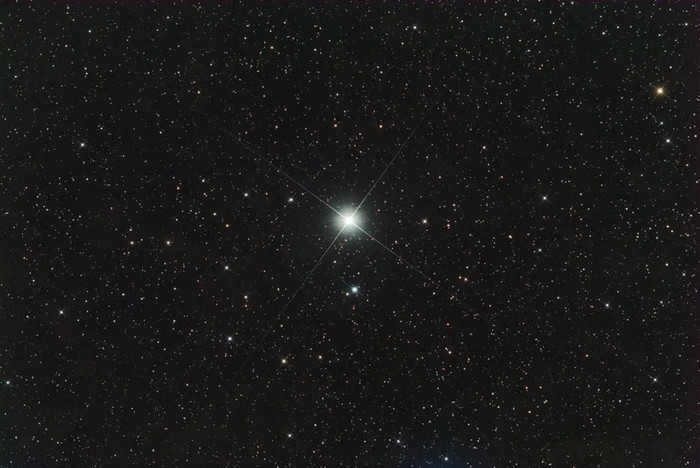
It is perhaps the most well-known star among humans. Furthermore, its popularity began to rise during ancient times when the Sun was not regarded as a star. However, it must be noted that its status as a “star” is relatively recent in terms of history, and also quite fleeting.
She is suspected of possessing a certain degree of brilliance, although she is not the most brilliant, but rather average in this regard. Some individuals believe that she is the closest. However, that is also not true. There is a notion that Polaris can be seen from every corner of the Earth, and that it can be used to navigate in all oceans and deserts across the globe. But even this notion is incorrect. Only those who are knowledgeable about astronomy truly understand the significance of this celestial body.
What makes Polaris so renowned?
Above all, its position on the celestial sphere, which is relatively close to the North Pole of the world – a point on the celestial sphere where the imaginary axis of the Earth’s rotation intersects with the imaginary sphere – by a very small margin. The position of Polaris roughly aligns with this point.
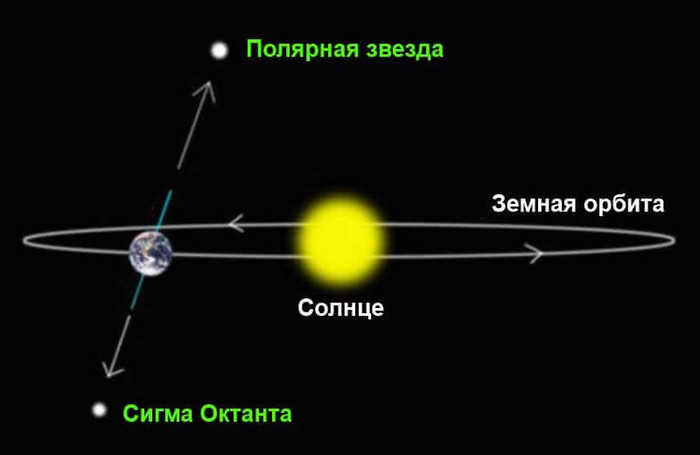
Doesn’t it seem like a significant amount of abstraction that necessitates a considerable amount of imagination?
It’s actually quite straightforward. If you extend the line connecting the Earth globe’s poles – north and south – in the northern direction, this line will accurately point to Polaris.
Observing this celestial body from any location in the northern hemisphere of the Earth will consistently reveal the direction of the Earth’s axis of rotation.

However, unfortunately, Polaris cannot be seen in the southern hemisphere. It remains invisible throughout the year, both in winter and summer.
Therefore, its utility for maritime navigation is quite limited.
Nevertheless, it is precisely its navigational significance that has made it immensely popular. The beginnings of seafaring can be traced back to the northern hemisphere.
For ship captains and navigators, locating this star in the night sky and using a plumb line to determine north became an incredibly straightforward method for finding their bearings and establishing all directions while out at sea (east, south, west), where other landmarks are nonexistent. Only the stars offer guidance.
However, the stars undergo a change in their position relative to the horizon over time – they rise and set. During the night, they sometimes traverse the entire sky. It is not possible to navigate a ship based on a star that is also moving, even if this movement is deceptive and caused by the rotation of our planet.
Only Polaris consistently shines directly above the northern point.
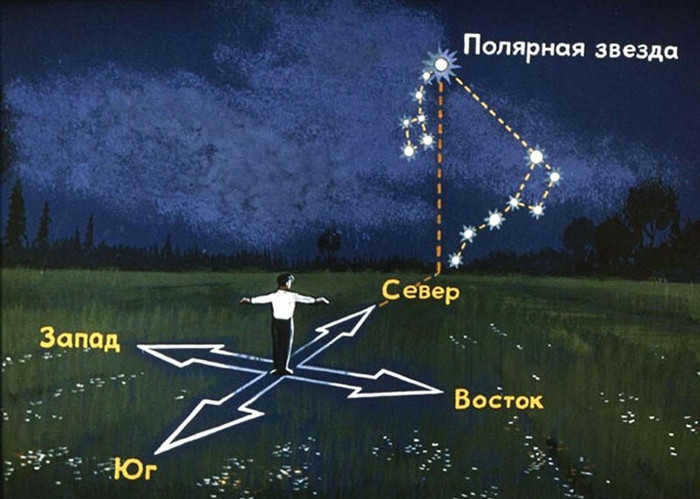
By using special tables and corrections for refraction, you can accurately determine the latitude of the observation location using Polaris. These tables allow for a much more precise measurement, not just to the nearest degree, but to the nearest one or two angular minutes, which is equivalent to a few kilometers. This level of accuracy is sufficient for locating even very small islands.
Unfortunately, Polaris does not provide any assistance in determining longitude. There are other methods available for this purpose. However, this article does not focus on marine navigation.
How did Polaris come to be positioned so close to the North Pole on the celestial sphere? How long has it occupied this position?
And even in the northern hemisphere, but several millennia ago, no one used Polaris for ship navigation. It didn’t even go by that title in those days.

Polar Alpha of the Little Bear is a name that came into use relatively recently. It was during the Renaissance that it began to be referred to as such, thanks to the Dutch cartographer Gemma Friesus. In 1547, he described it in one of his works as “stella illa quae polaris dicitur,” and the name stuck. Interestingly, at that time, Polaris was actually four times farther from the pole than it is today.
The Little Bear’s alpha had various names among different cultures in the past. The Greeks referred to it as “Kinosura,” which means “dog’s tail.” Interestingly, they didn’t see a bear in the constellation, but rather a dog. This dog was believed to have followed its mistress, the nymph Callisto, into the sky. Callisto had been transformed into a bear by the jealous goddess Hera, but was saved by Zeus and brought to the heavens.
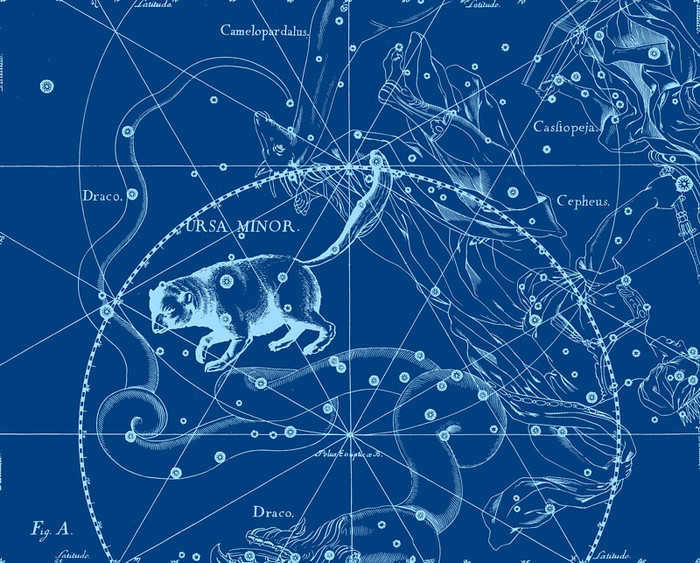
The ancient Celts gave it the name “Ship-Star” – “Scip-steorra” – a name that already hinted at its future use in navigation.
The ancient Arabs, known for naming most of the visible stars in the sky, called Polaris “Al-Judei”, which simply means “Father”. Many Arabic star names are still used in astronomy today. However, the ancient name of Polaris has been replaced and almost forgotten.
Regardless, in ancient times, when all these names for Polaris were coined, this star was not used for navigation, orienting oneself in terrain, or any related activities. It was far from the pole.
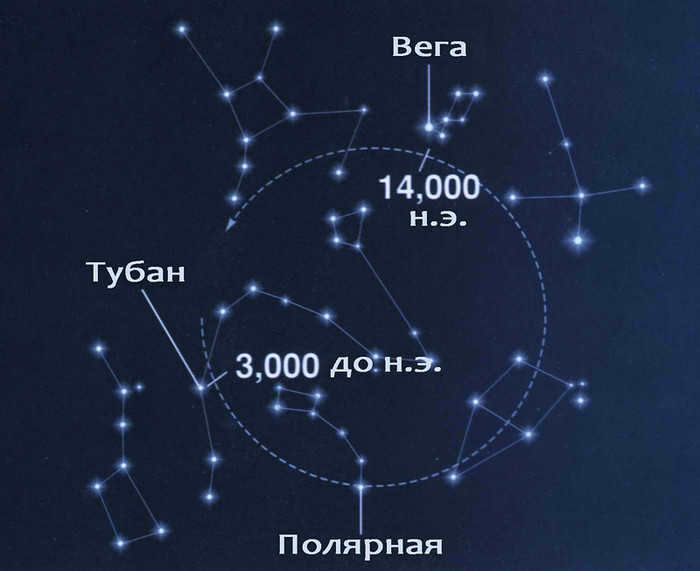
During the time of Archimedes and Pythagoras, the role of the “polar star” was fulfilled by a different star – the beta of the Little Bear, known as “Kohab” in Arabic, which means “Star of the North.” Even earlier, during the era of pyramid construction, the alpha of the Dragon – a star called “Tuban” – was the closest to the North Pole of the World in this sense.
Naturally, there was no Dragon on star charts at that time.
Over time, Polaris will no longer be known as “Polaris” and will be replaced by Cepheus Gamma in two thousand years. And another 10,000 years after that, the “polar” star for people in the northern hemisphere of Earth will be the stunningly beautiful Vega, the alpha star of the Lyra constellation.
What other interesting facts can be shared about Polaris?
As mentioned before, Polaris is the brightest star in the Little Bear constellation, where it serves as the alpha star. In all fairness, the beta star of the Little Bear, known as Cohabus, is only slightly dimmer than Polaris by a few hundredths of a star magnitude, making them nearly indistinguishable to the naked eye.
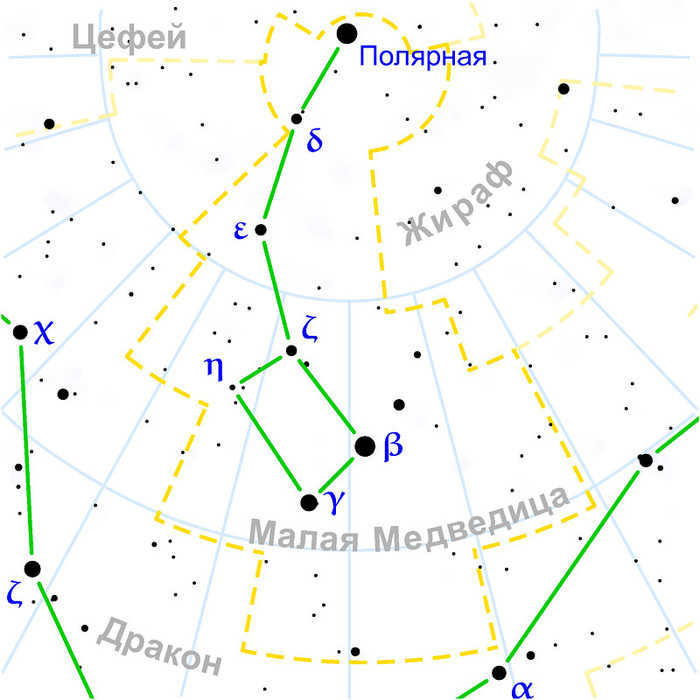
Polaris can be found by using the stars in the handle of the Big Dipper, as they are of similar brightness. By extending the line that connects the outermost stars of the handle five times, we will come across Polaris, a star with a magnitude of 2.
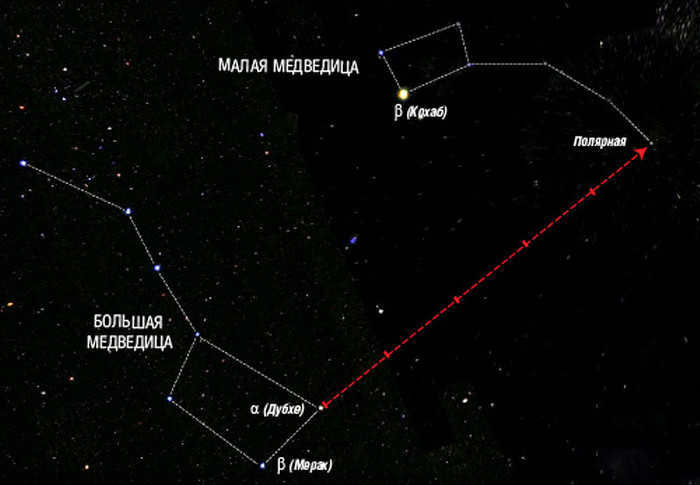
While it may not catch the attention of the average person, Polaris, also known as the North Star, holds great significance for astronomers due to its distinctive characteristics and unparalleled properties.
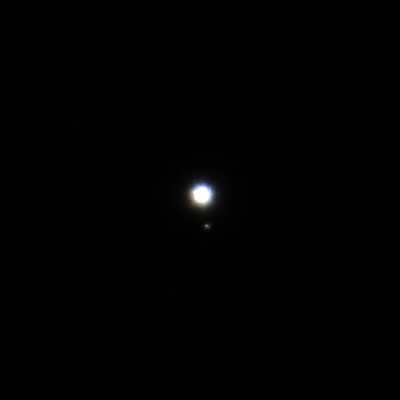
Polaris is a multiple star system. In an amateur telescope, it is possible (although challenging) to observe a faint companion star, Polaris B, which has a magnitude of 8. Another component of this system, Polaris Ab, is located much closer to the main star and can only be observed using the Hubble telescope or a similar one. At a distance from this trio, there are two more stars that float alongside each other in the same direction. Astronomers are still uncertain about their connection to Polaris – whether they are part of a stable system or members of an unstable scattered mini-cluster that will eventually disperse.
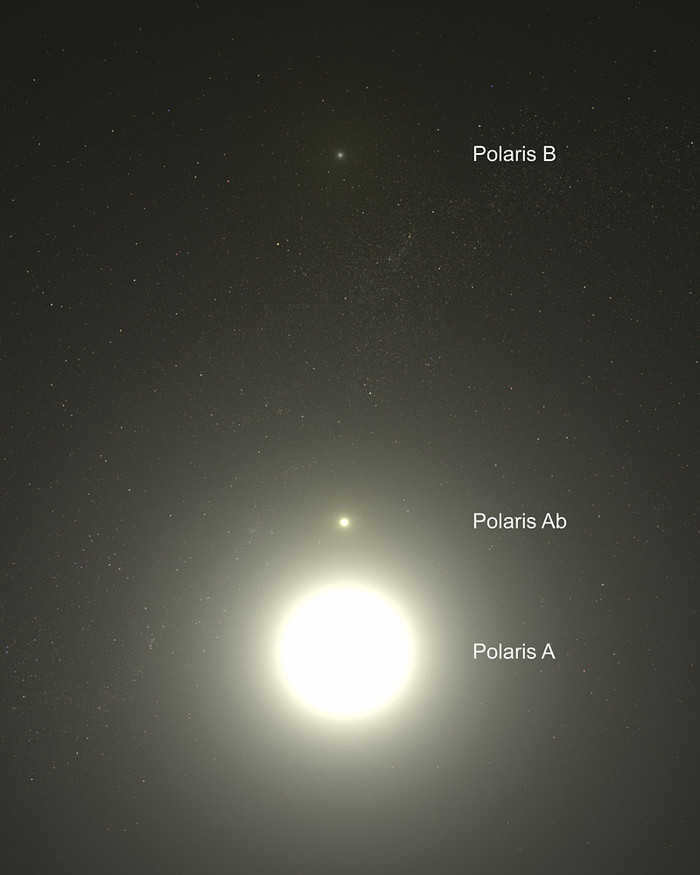
Within the vicinity of Polaris, astronomers have made observations of a specific group of stars that have a consistent level of brightness – known as the Northern Polar Series. These stars are used as a standard reference for measuring the luminosity of other stars, as their constant elevation above the horizon ensures that the atmospheric absorption of their light remains constant, assuming clear and transparent skies, since their elevation does not fluctuate.
There was a period when Polaris itself was part of this group and acted as a prime example of a stable star.
It is now understood that Polar pulsates, altering its brightness in the same manner as most Cepheids, which are a type of variable star like Cepheus delta. However, Polaris possesses a peculiarity that sets it apart as a unique cepheid. Firstly, the extent of Polaris’ brightness variation is very slight, amounting to only a few hundredths of a star magnitude. This is why it was considered stable in the absence of accurate photometers. Furthermore, over the course of its observation, the amplitude of Polaris’ light change has diminished by a factor of four, while the overall brightness of the star has increased. In the last century alone, Polaris has become approximately 0.2m brighter, which is significant in the field of astronomy.
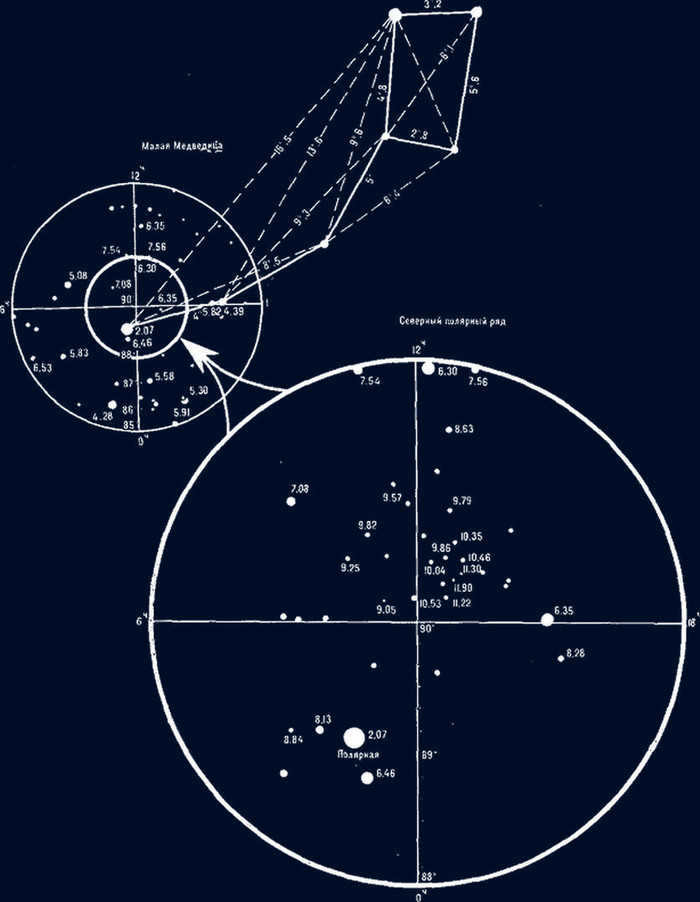
The future outcome of the ongoing evolution of Polaris remains uncertain.
The distance to Polaris is vast. According to different calculations, it ranges from 300 to 500 light years (currently estimated at 447 light years and decreasing). The significant variation in distance is due to the inability to accurately measure the parallax of such distant stars. Nonetheless, Polaris is considerably further away than the stars in the Big Dipper, which appear to have the same brightness. This implies that Polaris must have a much higher actual luminosity than the stars in the Big Dipper.
Polaris belongs to the supergiant category. It possesses a white-yellow shade – somewhat similar to the Sun, but surpasses the Sun in luminosity by a factor of one and a half thousand, and in mass – by six times.
These types of stars don’t have a very long lifespan, and in a few million years, Polaris will undergo a supernova. However, until then, it has the potential to serve as a guiding star for the inhabitants of planet Earth multiple times over.
Concluding the article, there is a musical bonus – for those individuals who have read the entire text. A piece dedicated to the nymph Callisto, mentioned in the article, whose dog carries the crucial Polar Star in its tail.
The composition “Nymph Callisto” is featured in my album Star Bridge.

Polaris, Phoenice, Alruccabah, Lodestar, Navigatoria, Cynosura. No, this is not a spell that has the power to summon an unknown being. These are the various names of a highly renowned celestial body. And it is not Olga Buzova. No. Our present discourse concerns Alpha Minor. That is the official designation of this celestial object. And the informal name it goes by is Polaris.
Contrary to deeply ingrained notions, Polaris can be observed not solely on Fridays during the polar winter from the North Pole and related regions. It can be sighted much farther to the south. All the way down to the equator. And sometimes even slightly lower.
Fascinating Information about Polaris
Surprisingly, Polaris is easily visible to the naked eye. It possesses two distinctive characteristics that facilitate its identification. Firstly, there are no stars surrounding Polaris that shine brighter than it does. As a result, it is quite challenging to mistake it for any nearby stars. Secondly, Polaris is positioned almost precisely at the spot in the sky where the North Celestial Pole is situated. What exactly is the North Celestial Pole, you may wonder? Well, it is actually quite simple. If you mentally visualize the axis around which our planet rotates extending upwards into the sky, it will come extremely close to Polaris.
Therefore, the Earth completes a full rotation on its axis within a 24-hour period. From our perspective as inhabitants of the Northern Hemisphere, it appears as though all the stars orbit around the Earth’s axis of rotation once every day, with Polaris serving as the focal point.

Due to its position directly above the Earth’s North Pole, Polaris serves as a clear indicator of the north direction for all observers. In previous times, Polaris held great significance for navigation, especially at sea or in the absence of a compass. Even today, it can still be used as a reliable reference point, such as during hiking trips. It is easily identifiable even without extensive knowledge of astronomy.
How to locate Polaris
To locate Polaris, all you need to do is locate the constellation known as the Big Dipper. This collection of stars is highly noticeable and well-known, making it difficult to miss. If you extend the line connecting the bright stars at the “back” of the Big Dipper’s “bucket” approximately five times, you will find yourself right at Polaris. From there, you will instantly be able to determine the direction of north.
For a long time, Polaris has served as a reliable indicator of the North Pole. However, this has not always been the case. The Earth’s axis of rotation gradually changes its direction over time, tracing a small circle over a period of 26,000 years.
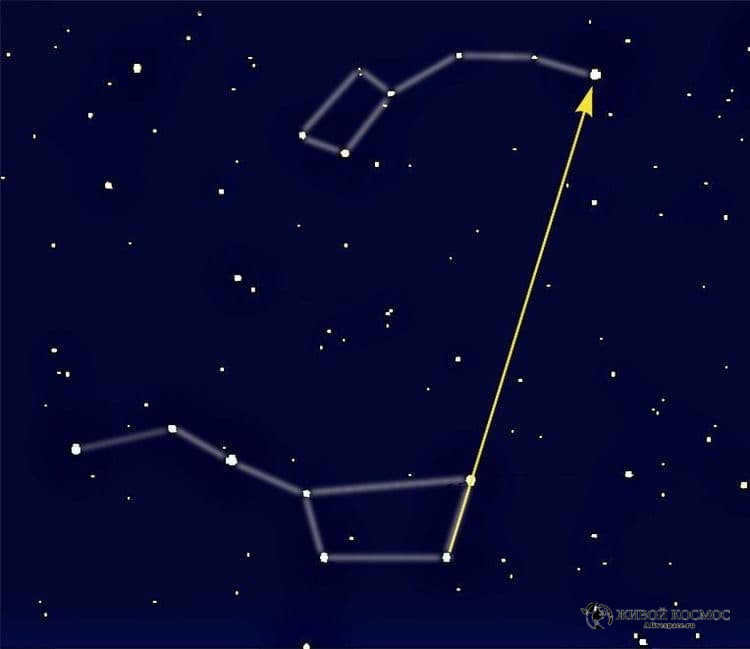
When Pytheas, a Greek geographer, sought to document the area around the North Celestial Pole in the third century B.C., he was dismayed to discover the absence of stars in that region! At that time, the Earth’s axis of rotation pointed towards a direction devoid of any notable stars. However, between one and one and a half thousand years earlier, the star Tuban from the Dragon constellation served as the illustrious Polaris. Furthermore, around 14,000 years ago, observers could gaze upon the brilliant star Vega at the celestial pole. If our future generations, reading this passage two thousand years from now, wish to locate their era’s Polaris in the night sky, they will need to locate Gamma Cepheus.
However, Polaris, my companions, is intriguing to us not solely from a navigational perspective. The reality is that it is from that location that UFOs and other extraterrestrial vessels make their way to Earth (just joking). It is also captivating from a purely astronomical standpoint. How about this intriguing piece of information, for instance – this celestial object is not actually a single entity. It consists of three separate objects! Two stars that form an extremely close binary star system. Polaris A is a massive yellow giant star with a mass 4.5 times that of the Sun and a brightness approximately 2000 times more intense! Its companion, Polaris Ab, is a dwarf star. The distance between these objects is merely about 20 astronomical units, which roughly corresponds to the distance between the Sun and Uranus. Situated at a distance of 2400 a.u. from the binary system is the sun-like star, Polaris B. It orbits around both components of the binary star system.
The Polaris system is located 433 light-years away from Earth, a distance that has been accurately measured using satellite instruments. It was previously believed to be around 330 light-years away.
The challenge in determining this distance was due to a lack of data on the nature of Polaris itself. Initially, it was classified as a type II Cepheid, a group of stars that belong to the population II category, which consists of older stars. In contrast, classical Cepheids, like our Sun, belong to the younger population I category. The only stars older than population II are the population III stars, which formed shortly after the Big Bang.
It is widely known how Cepheids undergo changes in their brightness. However, Polaris has proven to be unique in this regard.
Up until 1963, the star’s brightness had experienced a change of approximately one tenth of a star magnitude throughout its observed history. In other words, about 5 percent of its total brightness. However, after 1966, this rate of change significantly decreased to only about 2.5 percent. Recent observations indicate that the star is now becoming brighter once again. This behavior deviates from the typical pattern observed in Cepheids of this type. As a result, astronomers have concluded that the presence of the nearby companion, Polaris Ab, is somehow influencing this process.
It is evident that the change in the star’s brightness is directly linked to a change in its temperature. It is possible that the movement of objects in close proximity to each other may play a role in this phenomenon. However, this is currently just a hypothesis.
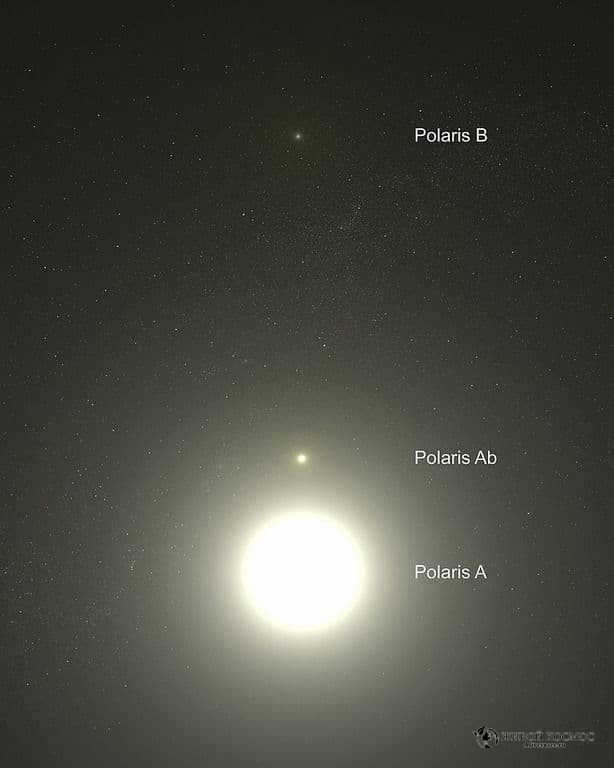
Unusual luminosity
The situation becomes even more fascinating when considering the observations made by ancient astronomers. Upon comparing the records of astronomer Ptolemy with those of today, it appears that the luminosity of Polaris has actually increased by 2.5 times! If this is indeed accurate, then this fact becomes quite intriguing, as such a significant change in brightness defies explanation.
As a result, astronomers and everyday people will maintain their fascination with Polaris for a long time. Scientists will persist in their efforts to decipher its peculiar characteristics, while regular individuals will continue to rely on it for guidance in the dark.
If the weather permits, take a moment to step outside on your front porch this evening. Locate Polaris and experience the sensation of a seafarer from ancient times, navigating an uncharted ocean towards enigmatic and unexplored territories….
Be sure to visit our new channel featuring peculiar jokes and mind-bending stories generated by artificial intelligence. Enjoy the absurd humor from ChatGPT.

Polaris is a yellow-white supergiant located approximately 430 light-years away from Earth. Situated in the constellation of Ursa Minor, this celestial body has an apparent stellar magnitude of 1.97, making it the 48th brightest star in the northern celestial hemisphere. Identifying Polaris is relatively straightforward as it can be found by locating the Big Dipper and using the stars in its “bowl” – Dubhe and Merak. By extending an imaginary line between these stars, one can easily pinpoint the exact location of Polaris.
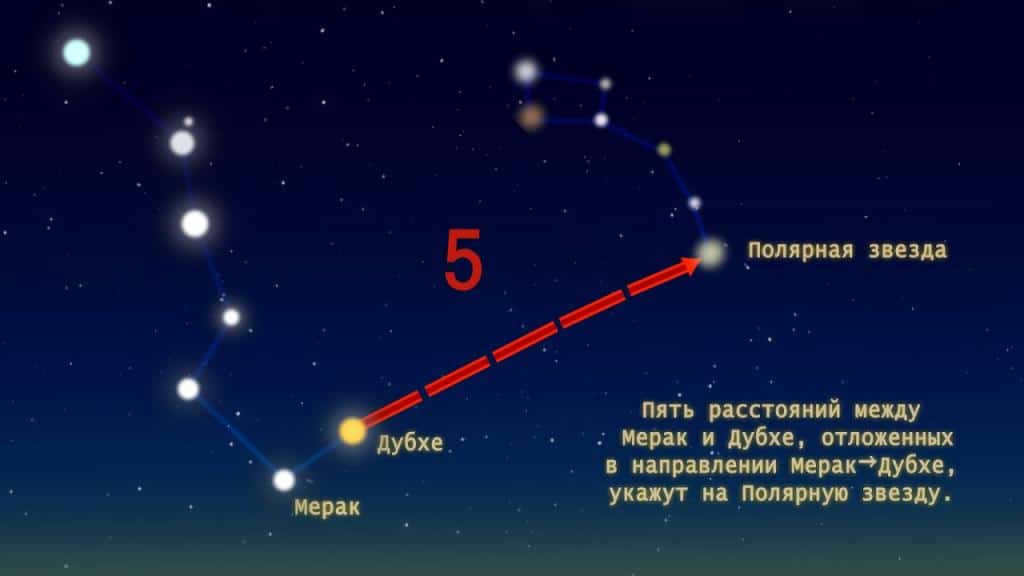

Nowadays, Polaris can be found in the sky near the North Pole of the Earth. If you were standing at the North Pole, you would need to look almost directly upwards to spot it. Polaris has an age of approximately 60 million years.
Polaris as a marker for measuring latitude
Indeed, Polaris can be observed directly overhead at the North Pole. However, as one travels south, it gradually sinks closer to the northern horizon. At the equator, it becomes visible only on the horizon. Further south, it disappears from view entirely. This phenomenon was utilized by sailors navigating the northern seas to determine their latitude. For instance, in Moscow, Polaris can be observed at approximately 56° above the horizon. Meanwhile, in Vladivostok, this angle decreases to about 45° when searching for Polaris in the night sky.
Because of the rotation of the Earth’s axis, stars undergo changes in their positions in the sky over time. For instance, around 3000 BC, the star Tuban, belonging to the constellation Draco, served as the northernmost star, also known as polarissima. During that period, the current Polaris was also in close proximity to the north celestial pole. It eventually reached its present location in the sky between the 5th and 6th centuries AD. Polaris will continue to serve as our celestial reference point until approximately 3000 AD. Afterward, the star Alrai (Gamma Cepheus) from the constellation Cepheus will take over, positioning itself almost perfectly at the North Pole.
It shines 2500 times brighter than the Sun
The distance between us and Polaris is stated as 430 light years. That’s quite a distance. However, Polaris is remarkably bright, with an apparent stellar magnitude of 1.97. This is due to its average brightness being more than 2,500 times that of our Sun!
We are incredibly fortunate to have such a crucial celestial object for easy navigation. The southern sky, in contrast, lacks such a guide. Well, technically there is something there as well. However, it is merely a small constellation known as Octanthus, which is extremely difficult to spot. In the southern sky, the role of Polaris is fulfilled by the relatively faint Sigma Octanta. It has an apparent magnitude of approximately 5 and is located within two-thirds of a degree from the South Pole of the world.
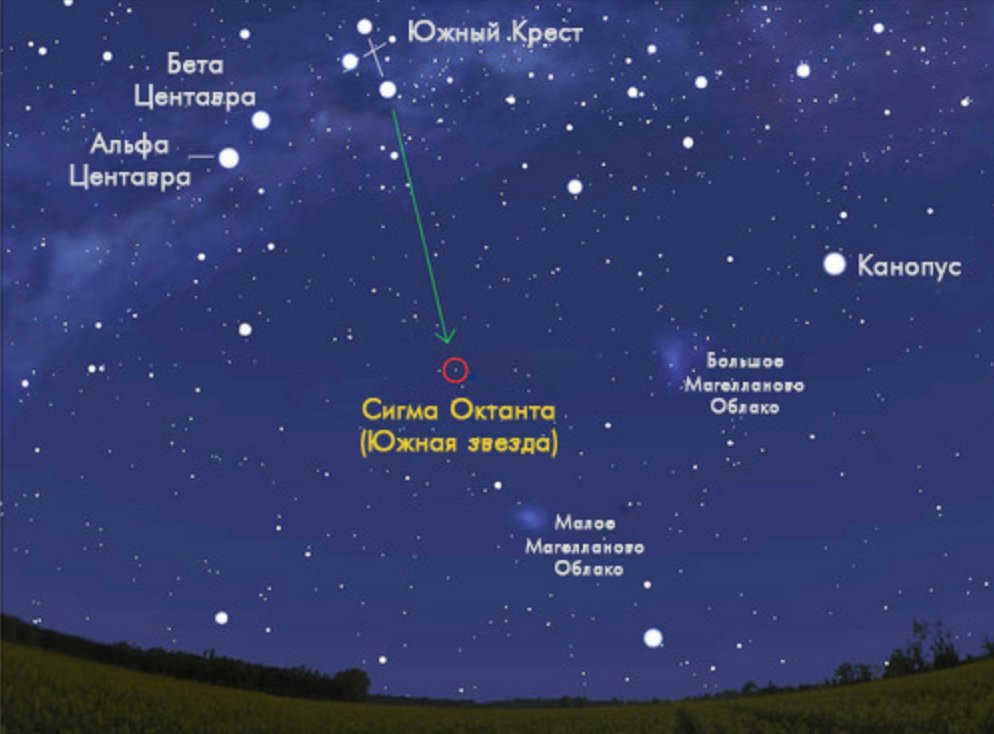
Part of a triple system
Polaris is a member of a triple star system. It consists of two other stars, one smaller and one larger. Polaris A (the star under discussion) and the dwarf Ab revolve around a common center of mass. Additionally, Polaris B orbits this binary star system at a distance of 2,400 astronomical units. It is speculated by astronomers that this system may contain not only three, but up to five components. This is due to the presence of two nearby stars that might be gravitationally bound to it. However, this hypothesis is yet to be confirmed.
The closest known Cepheid variable star
Polaris A, located 133 parsecs away from Earth (equivalent to about 3.26 light years), holds the distinction of being the nearest known Cepheid variable star. Cepheid variables are of particular interest due to their unique pulsation behavior, maintaining a consistent frequency. Notably, these pulsations can result in significant changes in diameter, a phenomenon that is intrinsically linked to their pulsation cycles. It was through this connection that Edwin Hubble made a groundbreaking discovery when he observed Cepheid variables in a neighboring galaxy. His findings conclusively demonstrated that the Andromeda nebula was, in fact, an entire galaxy!
Astronomers frequently rely on Cepheid variables to gauge distances within the vast expanse of space. By monitoring the fluctuations in brightness over time, scientists can accurately calculate these distances.
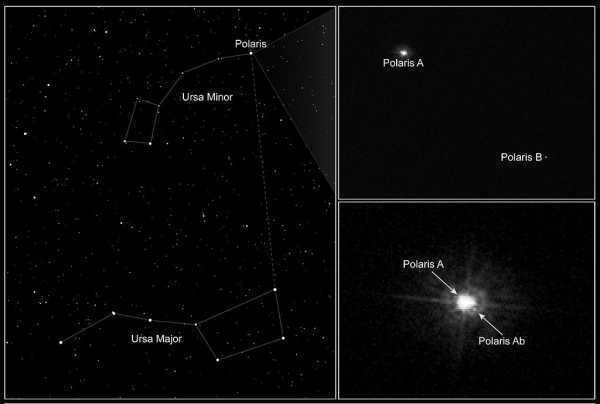
Stars
Polaris is positioned in close proximity to the northernmost point of the Earth. It belongs to the supergiant category and falls under the spectral class. Its distance from Earth is estimated to be around 447 light-years, although this measurement has not been fully explored and therefore remains uncertain. This article will provide a comprehensive overview of Polaris, including its detailed description and characteristics.
Characteristics of a general nature


Characteristics of Polaris
Polaris is larger in size compared to the Sun. It consists of the primary star and two smaller companions, along with the same number of distant components. One of these companions was discovered by W. Herschel in 1780. Polaris is part of the Ursa Minor constellation. It is highly regarded among astronomy enthusiasts due to its visibility and fascinating legends.
Irrespective of the circumstances, Polaris is situated within 1 degree (or even less) of the northern pole, making it nearly immobile in the daily motion of the sky. This fact provides a distinct advantage for navigation purposes, as the direction towards Polaris is nearly identical to the direction towards the north. Additionally, the elevation above the horizon is equivalent to the latitude of the observation location.
Due to the phenomenon of precession with respect to the Earth’s axis, the position of the North Pole is subject to change. Thus, Polaris was at its closest proximity to the North Pole between March 7th and June 13th, 2012. Subsequently, a process of separation began. According to scientists, by the middle of the year 2260, the distance will exceed the 1C threshold. In contrast, the southern hemisphere lacks a prominent Polaris.
Main Characteristics of the Object
Without a doubt, it can be affirmed that this object is the most brilliant and closest celestial body to the Earth. What makes it even more intriguing is its pulsating and variable nature. Its pulsations follow a specific pattern and occur over a period of approximately 3.97 days. However, this object also possesses a set of unique qualities:
- Over the course of several decades, the intensity of its pulsations gradually diminishes.
- In the year 1900, its luminosity experienced an 8% change, whereas in 2005, the change was only 2%.
- Throughout the duration of its observation by scientists, the brightness of this object has increased by approximately 15%.
- Contrary to common belief, this object is not a single luminary; rather, it is a triple system consisting of the supergiant Alpha and two other components.
- There is a fascinating theory suggesting that Polaris and the other prominent objects surrounding it might be the remnants of a disbanded cluster.
As the exact measurement of the distance is still uncertain, there is a potential for inaccuracies when determining distances to other galaxies. Consequently, improving this measurement will allow for the determination of distance scales and enable more precise calculations of various other characteristics.
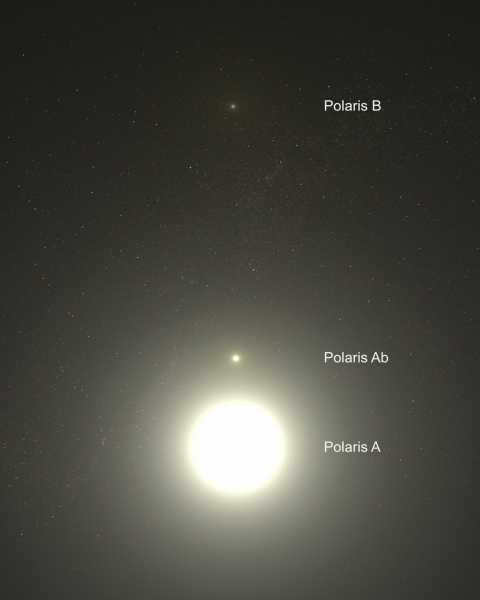

Polaris and the other stars that accompany it.
A brief history of Polaris
Polaris was given its name due to its significant role in astronavigation. Its distance from the North Pole is only 0.7 degrees, making it a crucial point of reference. It is also known by alternative names, with the most common translation meaning “dog’s tail”. This star has been utilized since ancient times, providing a reliable means of determining north and latitude.
The Alpha luminary is commonly known as “Polaris”. This association has been established since the 16th century. Currently, this celestial body reaches its maximum declination of 0.4603 degrees from the north pole of the sky (February 2012). It is projected to reach its highest declination of 0.4526 degrees on March 24, 2100.
Legends and myths related to the origin of the celestial object
One popular version is that during Zeus’ birth, the infant god was nourished by two bears. As a token of gratitude for saving his life, they were subsequently “transferred” to the sky. One bear was named “Small” and the other became known as “Big”. However, over time, the name “Big” came to be exclusively associated with the celestial body, which has raised many questions among scientists.
In ancient times, there was a belief among the Arabs that Polaris served as a sort of opening in the sky. This legend was prevalent in the eastern world. According to the legend, the malevolent celestial body became the slayer of the Heavenly Warrior, resulting in its eternal placement in a large coffin. Interestingly, the pattern on the coffin bears a resemblance to the pattern of the Big and Little Bear.
Physical Characteristics
Polaris possesses rather average physical characteristics. Utilizing amateur equipment, it is feasible to observe its yellow color, which continues to astound many individuals (most still assume that the star is white). In terms of temperature, the object slightly surpasses the Sun, averaging around 6000 K, but that is where the similarities to our natural celestial luminary cease.
Its luminosity far exceeds that of the Sun, and various studies have confirmed that Polaris is classified as a supergiant. It boasts a diameter 23 times larger than the Sun and a luminosity 2500 times greater. However, due to the inability to accurately measure the distance, these values may be somewhat unreliable.
Unique Features of a Supergiant’s Life
According to many scientists, Polaris has likely existed for a significant duration, considering that the majority of Supergiants are in their later stages of life. It is speculated that in the past, Polaris was luminous and had a blue hue, with a mass five times greater than that of the Sun and a radius 3.5 times larger. Its surface temperature was estimated to be 18,000 K. However, the current state of Polaris reveals different characteristics.
Polaris is composed of a Cepheid, which serves as a standard for measuring distance, making it a crucial component. Astronomers from different generations have been studying Polaris for years, and in 1852, they began to suspect that it had a variable nature. This suspicion was confirmed in 1911.
Since the discovery of this celestial body, scientists have been able to study the fluctuations in its amplitude.
- Until 1963, these fluctuations were greater than 0.1 magnitude, but then they gradually decreased.
- After 1966, the decrease became much more rapid, eventually reaching a level of 0.05 magnitude.
- Since then, there have been sporadic changes within this range. Currently, the light period is approximately 3.97 days and is steadily increasing.
- Recent measurements indicate a progressive increase in this parameter at a rate of 3.2 seconds per year.
New research indicates that Polaris is currently shining with more intensity than it has in the past.
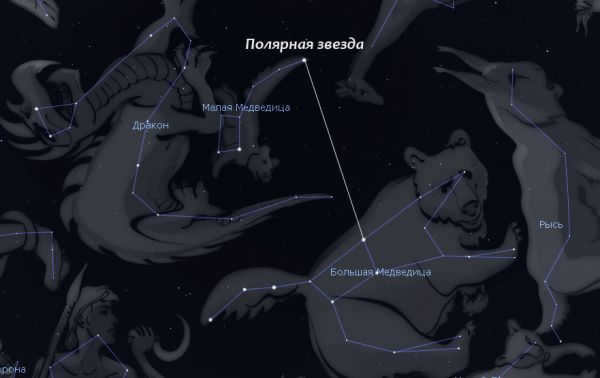
α of the Little Bear
Cepheids
There are numerous celestial bodies similar to the object being studied in the field of astronomy. Thus, it is not unique in terms of its physical characteristics. Scientists have even identified a distinct group of Cepheids. Despite having the same pulsations, these Cepheids differ in size, mass, temperature, and rotational amplitude. The only common factor among them is the direct relationship between luminosity and the period of pulsations.
Once upon a time, this regularity played a nearly decisive role. The key point is that it allowed for the reliable determination of the distance to those galaxies and others. There are 40 units of Cepheids. They have classical characteristics and can be observed by the average observer without specialized equipment.
So, what sets Polaris apart? It’s quite straightforward. The fact is that it indicates the north. Furthermore, this celestial body is the brightest and closest to the Solar System. As the use of these celestial objects as astronomical “rulers” is actively practiced in modern times, scientists are extensively studying their variability.
Without a doubt, Polaris indicates the direction of north. “Alpha” is situated on the line that aligns with the axis of the Earth’s rotation. It remains largely stationary, and nearly all objects in the Northern Hemisphere orbit around it. Occasionally, an object may appear to shift its position, but this is a rare occurrence. Thus, it is typical for the Earth’s axis and Polaris to align along the same line.
The movement of the luminary across the sky plays a significant role in the Earth’s processes. In the coming centuries, this phenomenon will be directly related to the Earth’s axis procession. Scientists predict that after the 21st century, the Earth’s axis will shift, leading to a change in the position of the North Star. In the future, Gamma Cepheus will take over as the new North Star, estimated to happen around the 41st century. Currently, the distance from the pole of the world is equivalent to approximately 1.4 lunar disks.
Debates on the Distance and Changing Values
Scientists have conducted numerous studies regarding the determination of distance. Most of these studies have indicated that Alpha of the Little Bear is situated at a distance from Earth equivalent to 133 parsecs, or 434 light-years. Previous estimates, however, had a much smaller value. Recent studies suggest that Polaris is actually located 100 years closer than commonly believed.
The spacecraft Hipparchus was utilized in the research process, employing the technique of determining stellar parallax. The time interval from 1989 to 1993 was taken as the period. The device was capable of measuring the size of millions of celestial bodies with an accuracy level of 0.97 milliseconds. Consequently, the most precise data on distances and motion vectors were obtained.
All types of radio telescopes were actively involved in the research and were utilized to gather precise parallax measurements at relatively large distances. It is a fact that they necessitate a substantial radio source connected to a sparse object.
Scientists have compiled a chronology of distances over the years, as the data has been continuously evolving and subject to debate. The information is presented in the following list.
- In 1991, the measurement yielded a value of 433 years.
- During the annual period of 2006, the value amounted to 300 years.
- In 2008, the values became equivalent to 359 years.
- In 2012, the measurements yielded a value of 323 units.
This list of information is not comprehensive. It is speculative and subject to change during future analysis. Therefore, despite its proximity to the Solar System, Polaris remains enigmatic and necessitates thorough investigations into its distance and other attributes.
While not being the most brilliant star in the Northern Hemisphere, the North Polaris serves as a guide for numerous explorers and sailors. Locating it in the sky is a simple task – just calculate the position of the Little Bear, with Polaris being the brightest star in the constellation.
The distance to Polaris is 447 light-years. Whether this is a considerable distance or not can be understood by carrying out a series of basic arithmetic operations, resulting in a seventeen-digit number representing a more comprehensible distance in kilometers for humans. However, despite being at such an immense distance, the Alpha star of the Little Bear has played a significant role in the existence of humankind for many centuries.
Star names

Within the vast expanse of the cosmos, there exists a celestial body that possesses an abundance of appellations. Remarkably, the majority of these names are intrinsically linked to its position in relation to our planet. Situated at the pole, Polaris remains fixed for Earth, serving as a steadfast guide.
In various cultures, it is revered as a stake piercing the heavens, around which all other celestial entities orbit. This belief has given rise to numerous monikers:
These designations can be traced back to ancient texts of Turkic and Finno-Ugric peoples.
The name “Polyarnaya” emerged in Russia during the reign of Peter the Great, prior to which it was referred to as Severnaya. In the languages of the Khakass and Evenks, it takes on a distinct essence: “Tied horse” and “Hole in the sky”.
According to information from Wikipedia, the North Polar Star is known as Kinosura, which translates to “tail of the dog” in ancient Greek, and it is also referred to as the Alpha of the Little Bear.
Overview
Extensive research on this celestial body has revealed that it is larger in size compared to the Sun and has two small satellites. Based on the Hertzsprung-Russell diagram, it is positioned towards the upper region in terms of volume and falls into the category of supergiants with the following inherent characteristics:
- Its mass is 10 to 70 times greater than that of the Sun.
- Luminosity ranges from 30,000 to several hundred thousand times higher than solar parameters.
- Radius spans from 30 to 500 times larger.
Measurements of the Distance from Earth
Calculating the distance from our planet is a topic that sparks lengthy discussions among astronomers. Many individuals question the accuracy of the officially recorded data, suggesting that it may be off by as much as a third.
According to official records, Alpha of the Little Bear is located approximately 447 light years away, which is equivalent to 137.4 parsecs. To provide a more comprehensible perspective, we can describe it as follows:
- 1 light-year is equal to 9,460,730,472,580.8 kilometers.
- Therefore, by multiplying 447 years by this value, we can determine the approximate distance between Earth and North Polaris.
A giant’s journey through life

If you closely observe the North Polaris through a telescope, you will notice that it emits a yellowish glow. This is quite peculiar, as we previously believed it would emit a white light.
Similar to most other celestial bodies that serve as suns in their respective systems, Polaris shines brighter than our own sun, evident from a simple glance at the night sky. Its surface temperature measures around 6,000K.
Alpha’s lifespan is relatively short in comparison to other stars, and significant changes occur once its hydrogen core is depleted. This characteristic is common among nearly all stars classified as supergiants. Their existence spans several million years, earning them the title of pro-evolving cosmic entities.
These characteristics do not imply that they should be classified as ancient stars or constellations – the focus here is on their life cycle. Specifically for North Polaris, it has already crossed the halfway point of its existence.
If we attempt to construct a speculative hypothesis of what Alpha was like in the Milky Way galaxy many years ago, we can draw the following conclusions:
- The surface temperature reached 18,000 K, which is three times the temperature of the sun.
- It was five times heavier than the Sun, with a radius that exceeded it by 3.5 times.
Remember, all of these indicators were characteristic of the star a very long time ago, and its current parameters have already been mentioned earlier.
Debunking the misconceptions about Polaris
This celestial object possesses a plethora of characteristics and is the subject of various myths that can be found in almost every civilization throughout history. It has captivated humanity for centuries with its mysterious, luminous, and distant yet seemingly close nature. Polaris has always held a fixed position in the night sky, guiding sailors and lost travelers towards the North and South Pole.
According to Greek mythology, the Little Bear constellation is actually the son of Zeus, known as Arcadus. However, despite the long-standing relationship between humans and Polaris, there are several misconceptions surrounding it:
- The position of Alpha relative to the horizon will vary based on hemispheric displacement. As you move closer to the equator, you will notice that Alpha gradually sinks closer to the horizon.
- The belief that Alpha is the brightest star is incorrect. If you attempt to locate it for its brightness, you will likely be mistaken, as it is actually ranked 48th among all known stars. In the northern hemisphere, you may mistake Sirius or Vega for being brighter.
Locating Polaris in the sky: a step-by-step guide
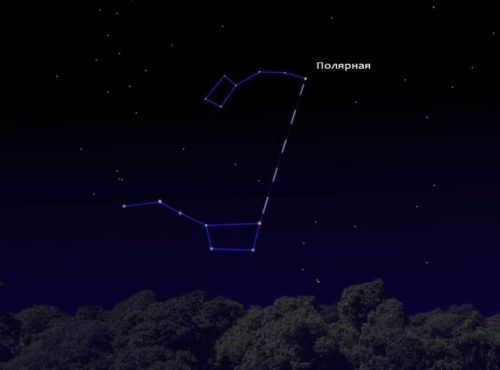
Locating North Polaris in the night sky can be done without the need for telescopes or other optical devices, assuming you have good eyesight. The North Star serves as a reliable indicator of the planet’s north pole.
The simplest method to find it is by identifying the surrounding constellations. The key here is precision: the stars within the constellations maintain a consistent position relative to one another, remaining stationary. As a result, the northern point can always be found at the tip of the Little Bear’s “tail,” shining brighter than the other stars in the constellation. The photo provided offers a visual representation of its location within the constellation.

If you are unable to locate it by constellation due to uneven cloud cover or lack of experience, there is an alternative method. You can determine its position using a camera of medium quality.
To do this, you need to capture the trail as shown in the photograph. Once you have done so, you can confidently conclude that the polar star is within your reach. Because its rotation frequency relative to the Earth is nearly zero, it will always appear at the center of the luminous trails.
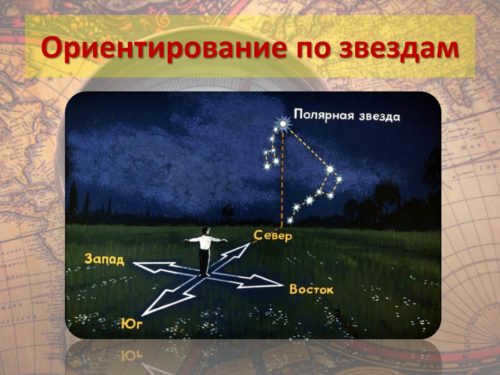
Throughout numerous years, Polaris has been a reliable guide for explorers navigating the lands of the Northern Hemisphere, allowing them to easily identify the cardinal directions. It may seem like specialized equipment is necessary for this task, but in reality, locating this star is surprisingly uncomplicated.
Video
"Polaris is the most renowned star in the celestial sphere."

